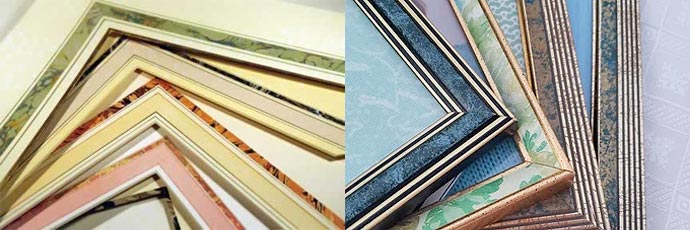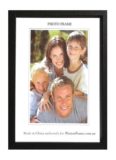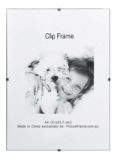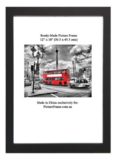![]() Picture frame mouldings? What are these? Well, let’s clarify it! These are long
Picture frame mouldings? What are these? Well, let’s clarify it! These are long  sticks of wood, often between 2.5 to 3.5 metres long, from which picture framers cut the sections of wood needed to make up picture frames. Picture framers order these sticks, or moulding lengths, in big boxes of various sizes from specific picture framing moulding suppliers. Note the adjective “specialized” within the phrase picture framing moulding? That’s needed because your local hardware store might also sell wood mouldings, but most certainly not picture framing mouldings. When four or more moulding sections are joined together, these then become, and are called, a "picture frame".
sticks of wood, often between 2.5 to 3.5 metres long, from which picture framers cut the sections of wood needed to make up picture frames. Picture framers order these sticks, or moulding lengths, in big boxes of various sizes from specific picture framing moulding suppliers. Note the adjective “specialized” within the phrase picture framing moulding? That’s needed because your local hardware store might also sell wood mouldings, but most certainly not picture framing mouldings. When four or more moulding sections are joined together, these then become, and are called, a "picture frame".
While picture frames are principally utilitarian, in so far that these are wooden constructions, or receptacles which sever to hold and display art, the moulding these are constructed form, can be highly decorative and belong o the world of decor.
Mouldings are often of complex design and highly finished to cater for a variety of Customer choices, tastes and preferences. We think that we can say that we are all familiar with the ubiquitous, ornate moulding such as the one shown below:

The above example is an ornate, baroque style frame. It is now seem largely and rarely in museum because modern decor shuns the style, colour, design and finish of baroque, or any ornate moulding. wether hand made or machine-finished.
The 1940's , 50's, 60s. and so on, each had their own styles. For instance, who hasn't come across a 1960's macrame , velvet-lined or rattan photo frame such as the example below during a Sunday Market visit?

Much the same can be said about the 1970's with their ubiquitous, solid, polished, brass photo frames look:

The 1980's was the age of colourful aluminium profiles in lots of pastel colours. Mauve, coral and teal greens were all the rage. Wide, chunky, geometric, moulding profiles were hot. This, after all, was the decade of the glamour Edelsten couple resplendent in bright yellow suit and hot pink dress.

There were certainly new styles and trends in the 1990's and the ones that we remember most were the Florentine wallpaper" mouldings as well as the fake inlaid finishes with lots of ridges and ridges mouldings tops:

The new millennium brought significant changes in the picture frames styling. Modern 21st century look, some called it. And this decor is still around, 20 plus years later, to stay here for good, perhaps. Gone are the lines, colours, styles and designs. The new style mouldings are now, white, or light or pale colours and a much simpler, neutral, colour palette.
Some call it the this light, modern minimalist decor the Scandinavian saturation because it has saturated most new, modern apartments, dwellings and houses. At its simplest, this involves large areas of white, off-white or light, pale colours, with white picture frames with white window mats, as in our A2 matted poster frames:

The other new and surprising picture fame styling phenomenon is the so called "Australian Tasmanian Oak " timber picture frame. The name is encapsulate within double commas as it is an appositive that further qualifies that naming.
In our State of Victoria, for instance, most of the so called "Tassie Oak" we have seen and handled is actually the locally grown Victorian Ash. Readers, and picture framers for that matter, may be excused for confusing the two species, and a couple of closely related ones, which are nearly identical to each other.

Tasmanian Oak is, botanically speaking; Eucalyptus Regnans and Eucalyptus Obliqua , while Victorian Ash is Eucalyptus Delegatensis. These eucalypti share many important and fundamental characteristics with minor variations, or differences.
When veneered, Tasmanian Oak results in somewhat darker veneers, while Victorian Ash displays lighter colours. Both are tough, durable, versatile and resilient, adding a natural warm feeling whenever and wherever these timber are used.
Either specie cuts, joins and stains well. Their colours and tones range from light pink to middle tan or light brown and once the mouldings are finished it is nearly impossible to differentiate, however younger trees have lighter tones while mature or older trees have darker ones.
Of the two timbers, Tasmanian Oak is more durable that Victorian Ash, with the former having a Janka rating of 5.5 and the latter, 4.5. Both are also highly versatile materials and highly suitable for picture framing mouldings, floors, handrails, staircases and many other interior, functional, or decorative, uses or purposes.
As to pricing, Tassie Oak can be somewhat cheaper as it of often more widely available locally than Vic Ash. As a last point, and so far as picture frame mouldings are concerned, these are nearly always sold to picture framers, as "raw".
This means that the moulding sticks are only milled and sanded and remain otherwise unfinished. Nevertheless, any large, prominent and major knots, shakes, burls. swirls, wanes, clusters, fissures or resin streaks present are generally sanded or milled off.
A good indication of the type and range of defects, flaws and variations that may be present in milled timbers is shown in the samples swatch below:

That being said, minor flaws and defects often remain and are not removed or filled, nor are the mouldings painted, foiled , veneered or decorated in anyway, hence the denomination, "raw".
Importantly, these colour, surface and texture variations are therefore intrinsic features to be foreseen and appreciated when evaluating and considering these types of timbers during a picture framing consultation.
In fact when our Customers are reviewing these mouldings, we take care to show them the actual sticks which often display all the variations mentioned here.
This is particularly important when Customers expect all frames in a suite or collection of prints, posters, or art, to exactly match and also, to avoid disappointments.
Yet another important consideration when contemplating these native timber picture is their cost. Broadly speaking the cost of locally produced and manufactured frames can be anything from 4 to 10 times the cost imported, China-made frames.
Many custom picture framers are unenthusiastic about imported photo frames and picture frames. This is understandable because these imports are much cheaper than locally manufactured products and many Customers, certainly a substantial majority, buy these.
This means less work for Australian picture framers and less money for the Australian picture framing industry and hence, this collective and widespread sentiment.
However, if Customers keep buying these frames, as they have been doing for years, it must be because they think that these are good value for money and worth buying.
The other, pervasive, criticism levelled at these frames is that they are, more or less, "rubbish". In our experience, and while certainly structurally inferior to a custom-made picture frames, most Asian imports are fine, and certainly worth the cheaper prices these are generally sold for.
The Made-in-China picture framing mouldings are generally of the paper-wrapped, or paper-foiled, extruded MDF manufacture. Shown below are some common profiles for the picture framing, cabinetry and carpentry trades:

And while the paper-wrap MDF moulding may not be as noble, as traditional or even as tough as a solid timber moulding, it is nevertheless a well-designed and well manufactured product with the factories producing these leaving nothing to be desired as to their modernity, professionalism and quality control:

A final thought on MDF mouldings for picture frames is that is that this manufacturing technology is already helping to supplant the harvesting of forest wood in many countries. In particular, when compared to the manufacture of PVC and plastic, extruded mouldings, these do help in reducing the world's carbon emissions.
Our own approach to this shopping conundrum is to proffer Customer a choice. Take for instance our popular B1 Natural Wood poster Frame below:

It is a ready-made poster frame constructed from paper-wrapped MDF moulding which suits either 70.7 x100cms or a 70x100 cms art. And below is the Australian-made Raw Oak counterpart. At the time of writing, the former is $64.95 and the latter $123.10.

As it can be seen, there's quite a price difference between the imported frame and the local one. When queried by Customers as to great price disparity between the two we simply point out to customers the relative features, advantages and disadvantages of each frame, some of these being listed below:
| B1 (70.7x100cms) Natural Poster Frame (SKU4133) | 70x100cms Raw Oak Poster Frame (SKU4136) |
| Less expensive price | More expensive price |
| Made in China | Made in Australia |
| Made with paper-wrapped MDF wood | Made with locally grown Victorian Ash timber |
| Clear plastic sheet glazing | Clear float glass glazing |
| Plastic does not easily break or shatter. It is safer than glass | Glass can easily break and shatter. It is less safe than plastic |
| Relatively light to hang, about 3.5 kgs | Relatively heavy to hang, about 7kgs |
| If marked or soiled, it cannot be easily cleaned | If marked or soiled it can be easily sanded off |
| May be hung with self-adhesive, wall hangers | Must nail in or drill in the wall hangers |
| No hand or power tools needed for installation | Either a hand or power tool needed for installation |
| Does not easily break in rough transit or if mishandled | May break in rough transit or if mishandled |
With the benefit of the additional, above information, Customers can then decide for themselves which of the two products may suit them best. Our experience that while about 70% of Customers opt for the cheaper poster frame about 30% choose the more expensive one.
The reasons they give for their preferences vary considerably but often it is felt that the locally grown Victorian Ask is more perferable, because of its more realistic colour, texture and appearance.
Summarizing, it seems as though the days of the browns, burls, pastels, old and silver-line mouldings is truly over, but who knows, any or all of them may come back in vogue in the future.










Quite helpful to see the information about the large Tasmanian Oak frames. These are a bit hard to find in the larger sizes. So it’s good to know about a Melbourne store that not only sells them, but also explains a bit and gives helpful tips about them.